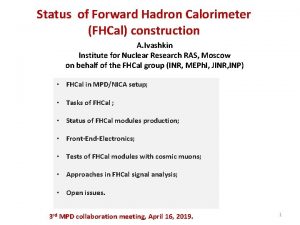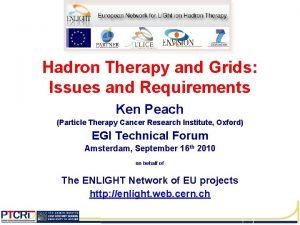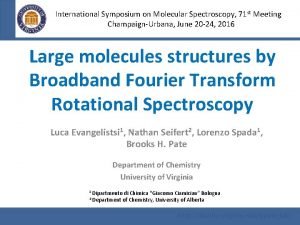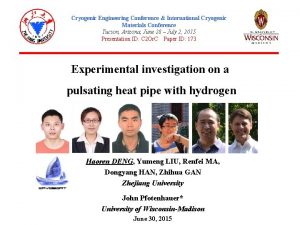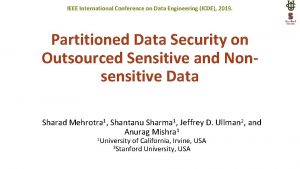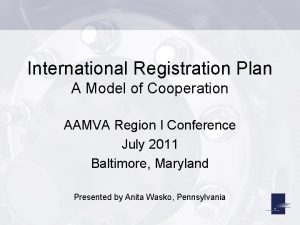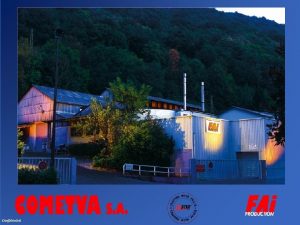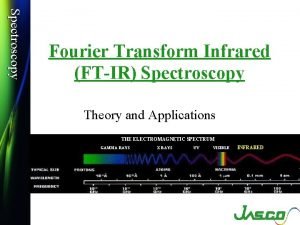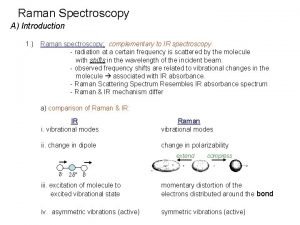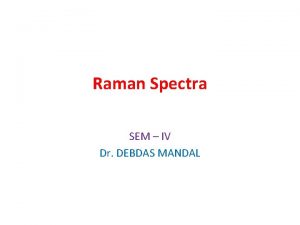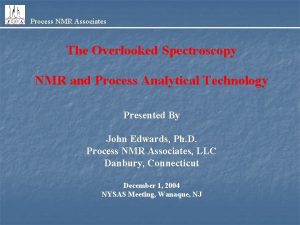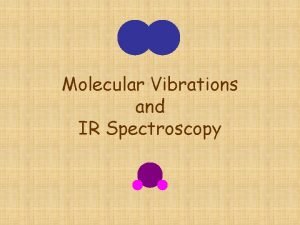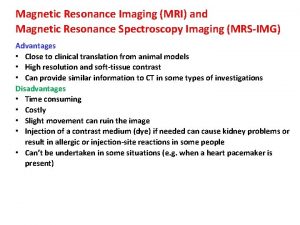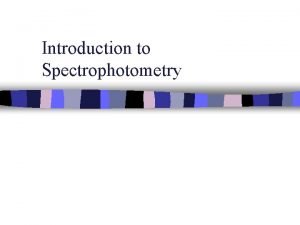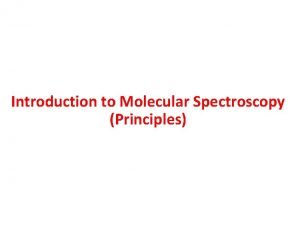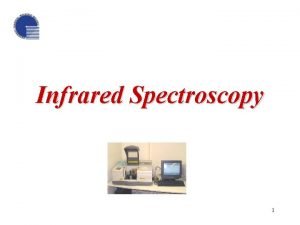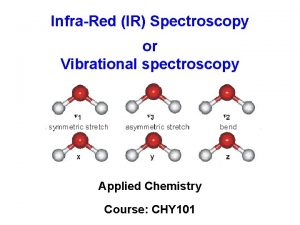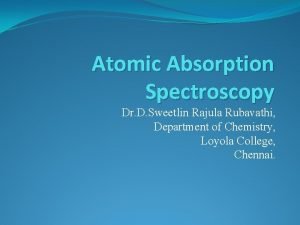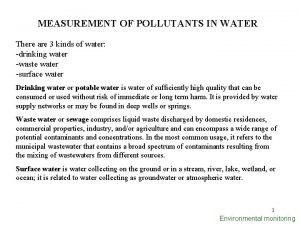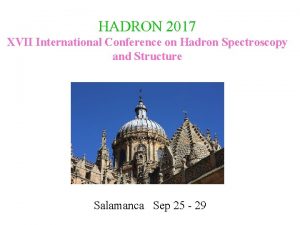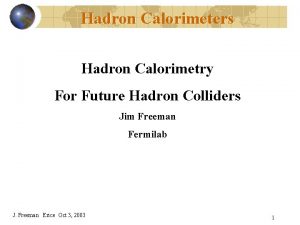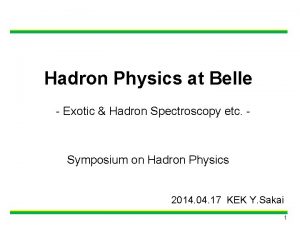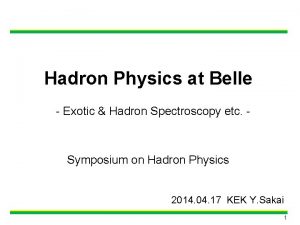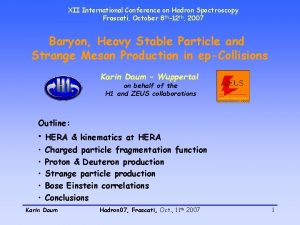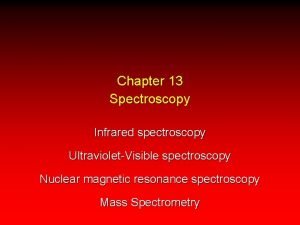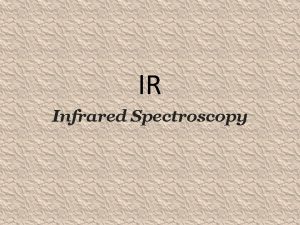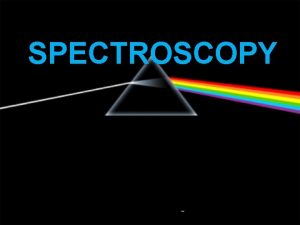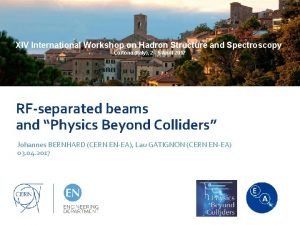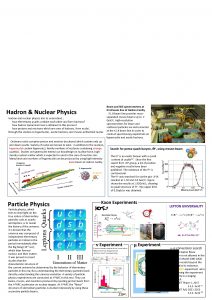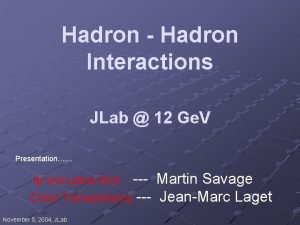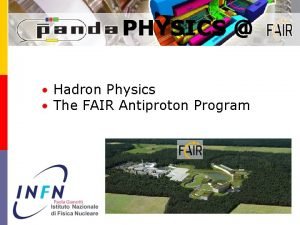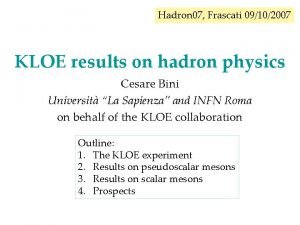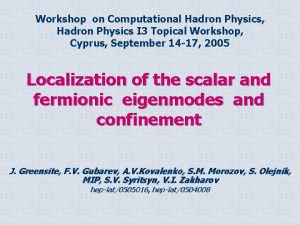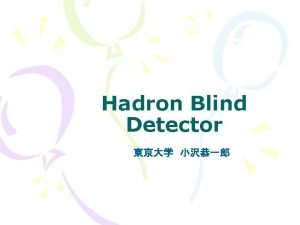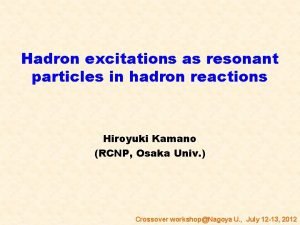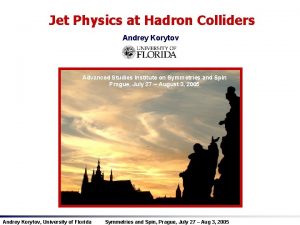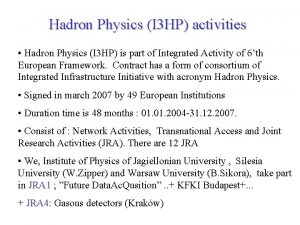19 th International Conference on Hadron Spectroscopy and


![Mr Rahul Mistry [1] https: //slideplayer. com/slide/4315864/ Mr Rahul Mistry [1] https: //slideplayer. com/slide/4315864/](https://slidetodoc.com/presentation_image_h2/67ec1cd3998b9bb44831dfe0e3f3d6ec/image-3.jpg)
![Ø X (3872) state observed in 2003 by the Belle collaboration[1] Ø Many unexpected Ø X (3872) state observed in 2003 by the Belle collaboration[1] Ø Many unexpected](https://slidetodoc.com/presentation_image_h2/67ec1cd3998b9bb44831dfe0e3f3d6ec/image-4.jpg)
![Four-charm tetraquark has been spotted at CERN by LHCb collaboration[1] Ø The first tetraquark Four-charm tetraquark has been spotted at CERN by LHCb collaboration[1] Ø The first tetraquark](https://slidetodoc.com/presentation_image_h2/67ec1cd3998b9bb44831dfe0e3f3d6ec/image-5.jpg)
![X(6900) Mr Rahul Mistry Ref: ar. Xiv: 2008. 01095 v 3 [hep-ph] 13 Oct X(6900) Mr Rahul Mistry Ref: ar. Xiv: 2008. 01095 v 3 [hep-ph] 13 Oct](https://slidetodoc.com/presentation_image_h2/67ec1cd3998b9bb44831dfe0e3f3d6ec/image-6.jpg)
























- Slides: 30

19 th International Conference on Hadron Spectroscopy and Structure in memoriam Simon Eidelman (26 -31 July 2021 Mexico City] “STUDY OF BRANCHING RATIO AND DECAY WIDTHS OF THE MAIN, HIDDEN AND OPEN CHANNELS OF TETRAQUARKS” By Mr. Rahul M Mistry V S Patel College of Arts and Science, Mr Rahul Mistry Bilimora, Gujarat, India.

OUTLINE Mr Rahul Mistry
![Mr Rahul Mistry 1 https slideplayer comslide4315864 Mr Rahul Mistry [1] https: //slideplayer. com/slide/4315864/](https://slidetodoc.com/presentation_image_h2/67ec1cd3998b9bb44831dfe0e3f3d6ec/image-3.jpg)
Mr Rahul Mistry [1] https: //slideplayer. com/slide/4315864/
![Ø X 3872 state observed in 2003 by the Belle collaboration1 Ø Many unexpected Ø X (3872) state observed in 2003 by the Belle collaboration[1] Ø Many unexpected](https://slidetodoc.com/presentation_image_h2/67ec1cd3998b9bb44831dfe0e3f3d6ec/image-4.jpg)
Ø X (3872) state observed in 2003 by the Belle collaboration[1] Ø Many unexpected exotic hadrons. , have been reported experimentally. Ø Several attempts have been made to describe the interaction between two mesons Ø Thus, its interpretation as a tetraquark state or a di mesonic molecular state remains unresolved. Mr Rahul Mistry [1] Belle Collaboration, S. K. Choi et al. Phys. Rev. Lett. 91 (2003) 262001, ar. Xiv: hep-ex/0309032.
![Fourcharm tetraquark has been spotted at CERN by LHCb collaboration1 Ø The first tetraquark Four-charm tetraquark has been spotted at CERN by LHCb collaboration[1] Ø The first tetraquark](https://slidetodoc.com/presentation_image_h2/67ec1cd3998b9bb44831dfe0e3f3d6ec/image-5.jpg)
Four-charm tetraquark has been spotted at CERN by LHCb collaboration[1] Ø The first tetraquark comprising all charm quarks and antiquarks have been discovered by studying the invariant mass distribution of two J/Ψ mesons produced in proton collisions at center-of-mass energies up to 13 Te. V Ø Tetraquark to be made entirely of “heavy quarks”, which are the charm and beauty quarks Mr Rahul Mistry [1]https: //physicsworld. com/a/four-charm-tetraquark-has-been-spotted-at-cern/
![X6900 Mr Rahul Mistry Ref ar Xiv 2008 01095 v 3 hepph 13 Oct X(6900) Mr Rahul Mistry Ref: ar. Xiv: 2008. 01095 v 3 [hep-ph] 13 Oct](https://slidetodoc.com/presentation_image_h2/67ec1cd3998b9bb44831dfe0e3f3d6ec/image-6.jpg)
X(6900) Mr Rahul Mistry Ref: ar. Xiv: 2008. 01095 v 3 [hep-ph] 13 Oct 2020

Ø The nature of the newly observed four-charm states is yet to be determined even though a compact tetraquark interpretation is preferred. Ø Identifying new kinds of tetraquarks and measuring their properties will help paint a clearer picture of these exotic inhabitants of the subatomic domain and provide an opportunity to understand the nature of the four-charm state. Ø "If the four-heavy-quark interpretation is correct, a full spectrum of these tightly bound states is expected to be discovered from the data that LHCb will be able to collect in the near future. Ø We make an attempt to predict masses of heavy tetraquarks in the framework of a non-relativistic quark model based on the potential approach Mr Rahul Mistry Article : LHCb collaboration. Observation of structure in the J/Ψ pair mass spectrum. Science Bulletin, 2020, 65(23) 1983 -1993


Mr Rahul Mistry

Mr Rahul Mistry

Mr Rahul Mistry

Mr Rahul Mistry

Mr Rahul Mistry

Mr Rahul Mistry

Mr Rahul Mistry

Mr Rahul Mistry

Mr Rahul Mistry

Mr Rahul Mistry

Mr Rahul Mistry

Mr Rahul Mistry

Mr Rahul Mistry Ref: Physics Letters B 811 (2020) 135952

The total decay rate is the sum of individual decay rates, obtained from the simple formula The colour singlet, spin 0 pair decays into 2 gluons, which are converted into confined, light hadrons, this decay leads to: T→ ηc +light hadrons. Mr Rahul Mistry

Mr Rahul Mistry

Mr Rahul Mistry

Mr Rahul Mistry

Mr Rahul Mistry Ref: Physics Letters B 806 (2020) 135495

Mr Rahul Mistry

CONCLUSION Mr Rahul Mistry T→ ηc + light hadrons T→ ηb + light hadrons T→ J/Ψ + light hadrons T→ 4μ T→ϒ + light hadrons T→ 4μ

Mr Rahul Mistry

Thank You Mr Rahul Mistry
 Hadron calorimeter
Hadron calorimeter Hadron collider
Hadron collider Hadron collider
Hadron collider Hadrons
Hadrons Hadron
Hadron International symposium on molecular spectroscopy
International symposium on molecular spectroscopy International cryogenic materials conference
International cryogenic materials conference International gambling conference
International gambling conference Fassi kafyeke
Fassi kafyeke Ieee international conference on data engineering
Ieee international conference on data engineering Parvuli dei banner examples
Parvuli dei banner examples International space development conference
International space development conference International telemetry conference
International telemetry conference Aamva international conference
Aamva international conference Cometva
Cometva Cit international conference
Cit international conference Asbo international
Asbo international Terahertz spectroscopy principles and applications
Terahertz spectroscopy principles and applications Ir spectroscopy definition
Ir spectroscopy definition What is the difference between ftir and raman spectroscopy
What is the difference between ftir and raman spectroscopy Difference between ir and raman spectroscopy
Difference between ir and raman spectroscopy Nmr associates
Nmr associates Stretching and bending vibrations in ir spectroscopy
Stretching and bending vibrations in ir spectroscopy Advantages of nmr spectroscopy
Advantages of nmr spectroscopy Introduction to spectrophotometry
Introduction to spectrophotometry Introduction to molecular spectroscopy
Introduction to molecular spectroscopy What is spectroscopy
What is spectroscopy Stretching and bending vibrations in ir spectroscopy
Stretching and bending vibrations in ir spectroscopy Principle of atomic absorption
Principle of atomic absorption Difference between atomic and molecular spectroscopy
Difference between atomic and molecular spectroscopy Catalysis lecture notes
Catalysis lecture notes
